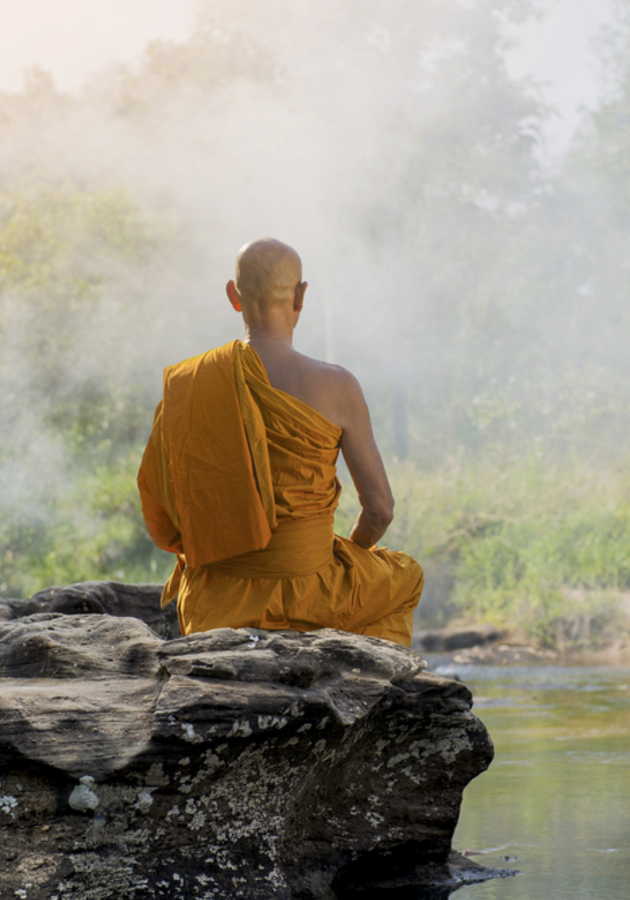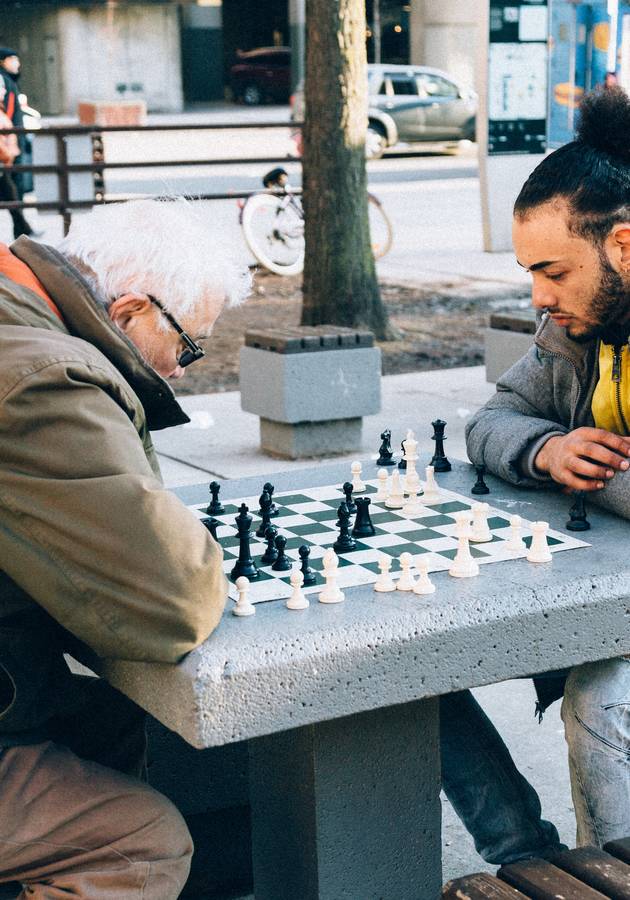When Jay Shetty was 18 years old, one of his friends invited him to hear an Indian monk named Gauranga Das give a talk on selflessness and living a minimalist lifestyle. Shetty was hesitant at first but by the end of the night he was converted. He decided to follow Das for the remainder of his lecture circuit around the United Kingdom and spent the next four summers in India training with the International Society for Krishna Consciousness. His values started shifting. One day, he decided to leave the corporate world behind him for good. Craving the presence of monks, he went to Mumbai, India, where he spent the following three years living a Vedic monk lifestyle at an ashram.
Based on Shetty’s experiences from the ashram, his debut book, “Think Like a Monk,” shares his learnings and offers advice on improving focus and reducing stress. In essence, the book suggests that whoever wants to be happy, first needs to learn how to liberate themselves from the confines of their assumed identity, their negativity biases and their fears. Only then their mind will have enough room to grow a purpose and positive routines, and only then will their heart truly be able to give others gratitude and compassion. Get ready to learn all of these things and connect yourself with the timeless wisdom of the Vedas!
You are a method actor
To prepare for the role of Bill the Butcher in Martin Scorsese’s “Gangs of New York,” Daniel Day-Lewis – one of the world’s foremost method actors and the only triple Best Actor Oscar winner – spent a year training as a butcher, hired circus performers to teach him how to throw knives, spoke with a thick Irish accent on and off the set and even wore authentic 19th-century clothing in the winter. “I will admit that I went mad, totally mad,” Day-Lewis said in an interview years later, stating the role was “not so good for [his] physical or mental health,” and that it left him exhausted and lost. It may surprise you to hear that he was consciously doing something you are doing unconsciously this very minute – adopting an identity that probably isn’t your authentic self.
As Shakespeare said, “all the world’s a stage and all the men and women merely players.” Whether we like it or not, we all have different personas – one for our parents, another one for our friends, a third one for our colleagues, and a sheer multitude of others for the online communities we belong to. Of course, each of these different personas has its benefits, enabling us to earn money, function properly in the workplace and even maintain relationships with people we might not really like but need to interact with nevertheless. However, this all comes at a cost. Just like in the case of Day-Lewis, being somebody other than yourself for long periods of time can be exhausting. In fact, this is the main reason why we often feel depressed, unworthy and unhappy: rather than living up to our own values, we are trying to live up to someone else’s.
At the beginning of the 20th century, American sociologist Charles Horton Cooley named this phenomenon the “looking-glass self.” He summarized it in the following mind-bending, but illuminating manner: “I am not what I think I am, and I am not what you think I am. I am what I think you think I am.” In other words, your identity is wrapped up not in what others think of you but in what you think others think of you. An existential philosopher would reproach you for allowing your authentic self to be imprisoned by the gazes of others. The Bhagavad Gita, an ancient 700-verse Hindu scripture that is part of the epic “Mahabharata,” says something even more profound: “It is better to live your own destiny imperfectly than to live an imitation of somebody else’s life with perfection.” Now, let us see how you can achieve this profound goal.
Audit your life to find out who you really are
“Your identity is a mirror covered in dust,” said once Gauranga Das to Shetty. “When you first look in the mirror, the truth of who you are and what you value is obscured. Clearing it may not be pleasant, but only when that dust is gone can you see your true reflection.” It was only later that Shetty discovered this was just a practical demonstration of the words of a 16th-century Bengali Hindu saint named Chaitanya (Chai-tan-yah), who called this state of affairs ceto-darpaṇa-mārjanam, or, “clearance of the impure mirror of the mind.”
The world we live in, says Shetty, “constantly pushes blatant and subliminal suggestions as to what we should want, and how we should live, and how we form our ideas of who we are.” Every movie you’ve ever watched, every book you’ve ever read, every person you follow online – they are all feeding your mind with ideas and values. The more you are absorbed in the ideas and values of others, the more your mind is tainted with “envy, judgment, competition, and discontent.” Just like most negative feelings in life, these are all deep-rooted in highly selective comparisons. We don’t like where we are because we feel someone is at a better place. Of course, since we know only aspects of other people’s lives, these comparisons are inherently flawed. Regardless, they affect us in a very negative way. “The more we define ourselves in relation to the people around us,” writes Shetty, “the more lost we are.”
The first step toward finding yourself is allocating enough space and stillness for self-assessment. There are four ways you can achieve this. First, on a daily basis, try to set aside 10 nonnegotiable minutes to sit down and reflect on how your day went by and what emotions it instigated in you. Second, try to go someplace you’ve never been before – whether it is a library, a park or another country – to explore yourself in a different environment. Next, get involved in “something that’s meaningful to you – a hobby, a charity, a political cause.” Finally, start tracking how much time and money you devote to your family, your friends, your health, your favorite TV shows and your self. If the areas where you spend your time the most time don’t match what you value the most, then you need to do some self-examination and change your life.
“The art of losing isn’t hard to master”
Most monastic traditions are founded on a twofold premise: letting go of the things that hold you back so that you can make room in your mind for the things that will propel you forward. “When we are buried in nonessentials,” writes Shetty, “we lose track of what is truly significant.” After auditing your life, you should be able to recognize the nonessentials in your life, the distractions, the expectations of others that lock you away on a daily basis. The next step is to learn how to leave them behind you so that you can prepare yourself for the final step: aligning your life to a set of guiding values. But first, let us delve a bit deeper into the art of letting go which, to paraphrase poetess Elizabeth Bishop, isn’t hard to master.
However, it isn’t easy as well. “When you try to live your most authentic life,” warns Shetty, “some of your relationships will be put in jeopardy.” Don’t be afraid to lose them, because this is a risk worth bearing. Only when you are able to tune out “the opinions, expectations, and obligations of the world” around you – or the OEOs, for short – you can begin to hear yourself. Tuning them out, though, doesn’t mean blocking them out permanently. It just means cleaning up your mind so that you can invite the OEOs back in once you acquire a new set of eyes to filter and judge them.
After all, you can’t shield yourself from negativity no matter how hard you might try. Moreover, since negativity is contagious, the more negativity there is around you, the more negative it makes you as a person. It is a vicious cycle from which you can only free yourself by stepping outside your own life to discover your true, authentic being. Only after finding your true values, you should become able to deal with negativity properly and with purpose.
Ways to deal with negativity and negative people
Negativity is everywhere. Not only do bad things happen to good people all the time, but also there are many individuals who tend to emit many different types of negative energy. Depending on the energy they radiate, Shetty categorizes these individuals into seven different groups: complainers, cancellers, casualties, critics, competitors, commanders and controllers. Categorizing the people you know along these categories can be fun, but it is useless. What is useful is utilizing the framework to step away from a negative person so that you can make a clearheaded decision about your role in a given situation.
There are two other good strategies to filter the noise of external influences and deal with the negativity that comes your way. The first one is the 25/75 principle, which can be summed up simply as having three uplifting people for every negative person you don’t have the freedom to let go or avoid. In sports, being around better players makes you a better player as well. The same is true in life. So, don’t just spend time with the people you love and care about – learn to grow with them. Shetty advises doing a workshop. Sangha is the Sanskrit word for community, and it suggests a refuge where people serve and inspire each other.
The second strategy for dealing with negativity is the three-step “spot, stop, swap” process. It works like this. First, you need to become aware of the toxic impulses around you and spot the negative thoughts they may instigate in your mind. Then you should address them: only by silencing and stopping your negativity can you “make room for thoughts and actions that add to your life instead of taking away from it.” After spotting and stopping the negative thoughts in your heart, you can begin to amend them by swapping the time you spend complaining, comparing and criticizing for time dedicated to empathy and compassion toward the other instead. The Hindus call this practice mudita and define it as “taking sympathetic or unselfish joy in the good fortune of others.” It is the exact opposite of the Western concept of Schadenfreude, which means taking pleasure in the suffering of others.
Grow your mind and find your purpose
According to the Bhagavad Gita, there are 20 higher values and six lower ones. The higher values include, among others, gratitude, service, acceptance, deep study, austerity, nonviolence, truthfulness, compassion, gentleness and restraint. The six lower values, on the other hand, are: greed, lust, anger, ego, illusion, and envy. The bad news in life is that, though fewer in number, the lower values are heavier (after all, the higher values are celestial), so when they take over, they can pull us down quickly. The good news is that “there are always more ways to be pulled up than to be pulled down.”
What’s pulling us down is our monkey mind, the oldest part of our brain that is interested only in itself and instant gratification. It is controlled by anger, worry, and fear. It is self-centered and obsessed, demanding and entitled, distracted by small things and in constant pursuit of pleasure and temporary fixes. The monkey mind “switches aimlessly from thought to thought, challenge to challenge, without really solving anything.” The monk mindset is its exact opposite: always focused on the root of an issue, it lives intentionally and consciously. It is disciplined and enthusiastic, determined and patient. Rather than pleasure, it looks for meaning and genuine solutions; rather than amplifying negatives and fears, it works on breaking them down.
Adopting the monk mindset means two things: letting go of your “monkey mind” and embracing your dharma. The Sanskrit term dharma can’t be translated into a single English word, but saying something is “your calling” is a pretty good approximation. In Shetty’s opinion, dharma is a combination of varna (passion and expertise) and seva (the world’s needs). As he notes, “when your natural talents and passions (your varna) connect with what the universe needs (seva) and become your purpose, you are living in your dharma.” Only by living in your dharma you can experience fulfillment. That’s why the Bhagavad Gita advises people to live their destiny imperfectly. In his 2005 Stanford commencement address, Steve Jobs put it just as memorably: “Your time is limited, so don’t waste it living someone else’s life.” Follow your bliss.
Final notes
“Think Like a Monk” isn’t your typical, generic self-help book. Embedded in experience, Shetty’s debut combines ancient Eastern wisdom with the realities of the modern Western world and, rather than merely aiming to provide a short-term boost of positivity, it advocates for a long-term mindset transformation.
In the words of Arianna Huffington, read this book if you want to “open your mind, lift your heart, redefine success, and connect with your deeper purpose.”
12min tip
Two lies are responsible for most of the suffering in this world. The first one is, “You’ll never amount to anything” and the second one is, “You can be anything you want to be.” The truth, according to Shetty, is simple and twofold: “You can’t be anything you want. But you can be everything you are.” So, try to become just that. Whatever people tell you, it is plenty; it is more than enough.





























